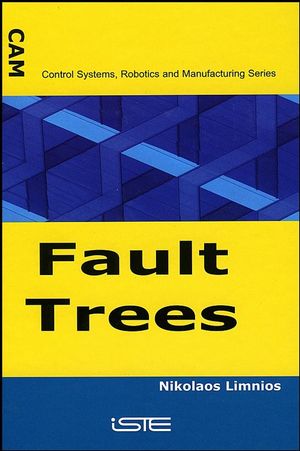Fault TreesISBN: 978-1-905209-30-9
Hardcover
150 pages
January 2007, Wiley-ISTE
 |
||||||
Introduction 11
Chapter 1 Single-Component Systems 17
1.1 Distribution of failure and reliability 17
1.1.1 Function of distribution and density of failure 17
1.1.2 Survival function: reliability 18
1.1.3 Hazard rate 19
1.1.4 Maintainability 19
1.1.5 Mean times 20
1.1.6 Mean residual lifetime 21
1.1.7 Fundamental relationships 21
1.1.8 Some probability distributions 22
1.2 Availability of the repairable systems 25
1.2.1 Instantaneous availability 25
1.2.2 Asymptotic availability 26
1.2.3 Mean availability 26
1.2.4 Asymptotic mean availability 27
1.3 Reliability in discrete time 27
1.3.1 Discrete distributions 28
1.3.2 Reliability 28
1.4 Reliability and maintenance 29
1.4.1 Periodic test: repair time is negligible 29
1.4.2 Periodic test: repair time is not negligible 30
1.4.3 Mean duration of a hidden failure 30
1.5 Reliability data 31
Chapter 2 Multi-Component Systems 33
2.1 Structure function 33
2.2 Modules andmodular decomposition 36
2.3 Elementary structure systems 37
2.3.1 Series system 37
2.3.2 Parallel system 38
2.3.3 System k-out-of-n 38
2.3.4 Parallel-series system 39
2.3.5 Series-parallel system 39
2.4 Systems with complex structure 40
2.5 Probabilistic study of the systems 42
2.5.1 Introduction 42
2.5.2 Inclusion-exclusion method 43
2.5.3 Disjoint products 44
2.5.4 Factorization 46
2.5.5 Reliability bounds 46
Chapter 3 Construction of Fault Trees 49
3.1 Basic ideas and definitions 49
3.1.1 Graphic symbols 52
3.1.2 Use of the operators 53
3.2 Formal definition and graphs 56
3.3 Stages of construction 57
3.3.1 Preliminary analysis 58
3.3.2 Specifications 59
3.3.3 Construction 59
3.4 Example of construction 60
3.4.1 Preliminary analysis 60
3.4.2 Specifications 62
3.4.3 Construction 62
3.5 Automatic construction 63
Chapter 4 Minimal Sets 67
4.1 Introduction 67
4.2 Methods of study 68
4.2.1 Direct methods 68
4.2.2 Descending methods 71
4.2.3 Ascending methods 73
4.3 Reduction 74
4.4 Other algorithms for searching the cut sets 75
4.5 Inversion of minimal cut sets 76
4.6 Complexity of the search for minimal cut sets 78
Chapter 5 Probabilistic Assessment 79
5.1 The problem of assessment 79
5.2 Direct methods 80
5.2.1 AND operator 81
5.2.2 OR operator 81
5.2.3 Exclusive OR operator 82
5.2.4 k-out-of-n operator 83
5.2.5 Priority-AND operator 83
5.2.6 IF operator 83
5.3 Methods of minimal sets 84
5.3.1 Inclusion-exclusion development 84
5.3.2 Disjoint products 85
5.3.3 Kitt method 86
5.4 Method of factorization 88
5.5 Direct recursive methods 90
5.5.1 Recursive inclusion-exclusion method 90
5.5.2 Method of recursive disjoint products 91
5.6 Other methods for calculating the fault trees 92
5.7 Large fault trees 93
5.7.1 Method of Modarres and Dezfuli [MOD 84] 93
5.7.2 Method of Hughes [HUG 87] 94
5.7.3 Schneeweiss method [SCH 87] 95
5.7.4 Brown method [BRO 90] 95
Chapter 6 Influence Assessment 97
6.1 Uncertainty 97
6.1.1 Introduction 97
6.1.2 Methods for evaluating the uncertainty 98
6.1.3 Evaluation of the moments 99
6.2 Importance 103
6.2.1 Introduction 103
6.2.2 Structural importance factors 105
6.2.3 Probabilistic importance factors 106
6.2.4 Importance factors over the uncertainty 109
Chapter 7 Modules – Phases – Common Modes 111
7.1 Introduction 111
7.2 Modular decomposition of an FT 111
7.2.1 Module and better modular representation 111
7.2.2 Modularization of a fault tree 114
7.3 Multiphase fault trees 116
7.3.1 Example 117
7.3.2 Transformation of a multiphase system 118
7.3.3 Method of eliminating the minimal cut sets 118
7.4 Common mode failures 119
Chapter 8 Extensions: Non-Coherent, Delay and Multistate Fault Trees 123
8.1 Non-coherent fault trees 123
8.1.1 Introduction 123
8.1.2 An example of a non-coherent FT 126
8.1.3 Prime implicants and implicates 126
8.1.4 Probabilistic study 128
8.2 Delay fault trees 129
8.2.1 Introduction 129
8.2.2 Treatment 129
8.3 FTs and multistate systems 131
8.3.1 Multistate systems 131
8.3.2 Structure function 132
8.3.3 Stochastic description and function of reliability 135
8.3.4 Fault trees with restrictions 136
8.3.5 Multistate fault trees 138
Chapter 9 Binary Decision Diagrams 143
9.1 Introduction 143
9.2 Reduction of the Shannon tree 143
9.2.1 Graphical representation of a BDD 143
9.2.2 Formal BDD 145
9.2.3 Probabilistic calculation 147
9.3 Probabilistic assessment of the FTs based on the BDD 148
9.4 Research about the prime implicants 151
9.5 Algorithmic complexity 153
Chapter 10 Stochastic Simulation of Fault Trees 155
10.1 Introduction 155
10.2 Generation of random variables 155
10.2.1 Generation of a uniform variable 155
10.2.2 Generation of discrete random variables 157
10.2.3 Generation of real random variables 158
10.3 Implementation and evaluation of the method 159
10.3.1 The Monte Carlo method 159
10.3.2 Estimating the probability of the top event 160
10.3.3 Precision of the estimation 161
10.3.4 Acceleration of the convergence 164
10.3.5 Rare events 165
Exercises 167
Appendices 177
A BDD Algorithms in FT Analysis 179
A1 Introduction 179
A2 Obtaining the BDD 180
A3 Algorithm of probabilistic assessment 182
A4 Importance factors 183
A5 Prime implicants 184
B European Benchmark Fault Trees 187
B1 Description of the data 187
B2 Fault tree: Europe-1 188
B2.1 Structure of the fault tree (structural data) 188
B2.2 Probabilistic data 190
B2.3 Results 190
B3 Fault tree: Europe-2 191
B3.1 Structure of the fault tree 191
B3.2 Probabilistic data 192
B3.3 Results 192
B4 Fault tree: Europe-3 193
B4.1 Structure of the FT 193
B4.2 Probabilistic data 195
B4.3 Results 195
C Some Results of Probabilities 197
Main Notations 201
Bibliography 205
Index 221



